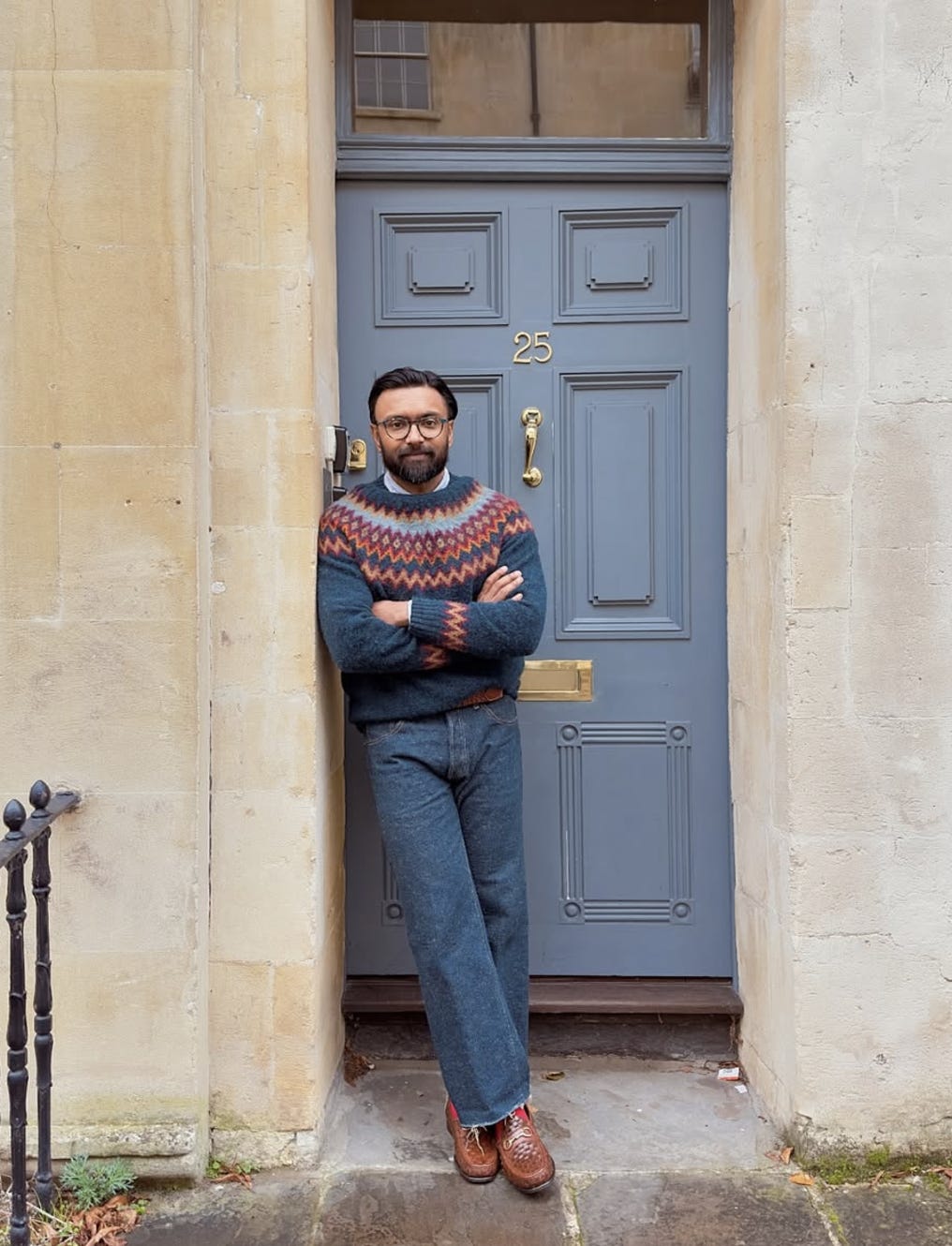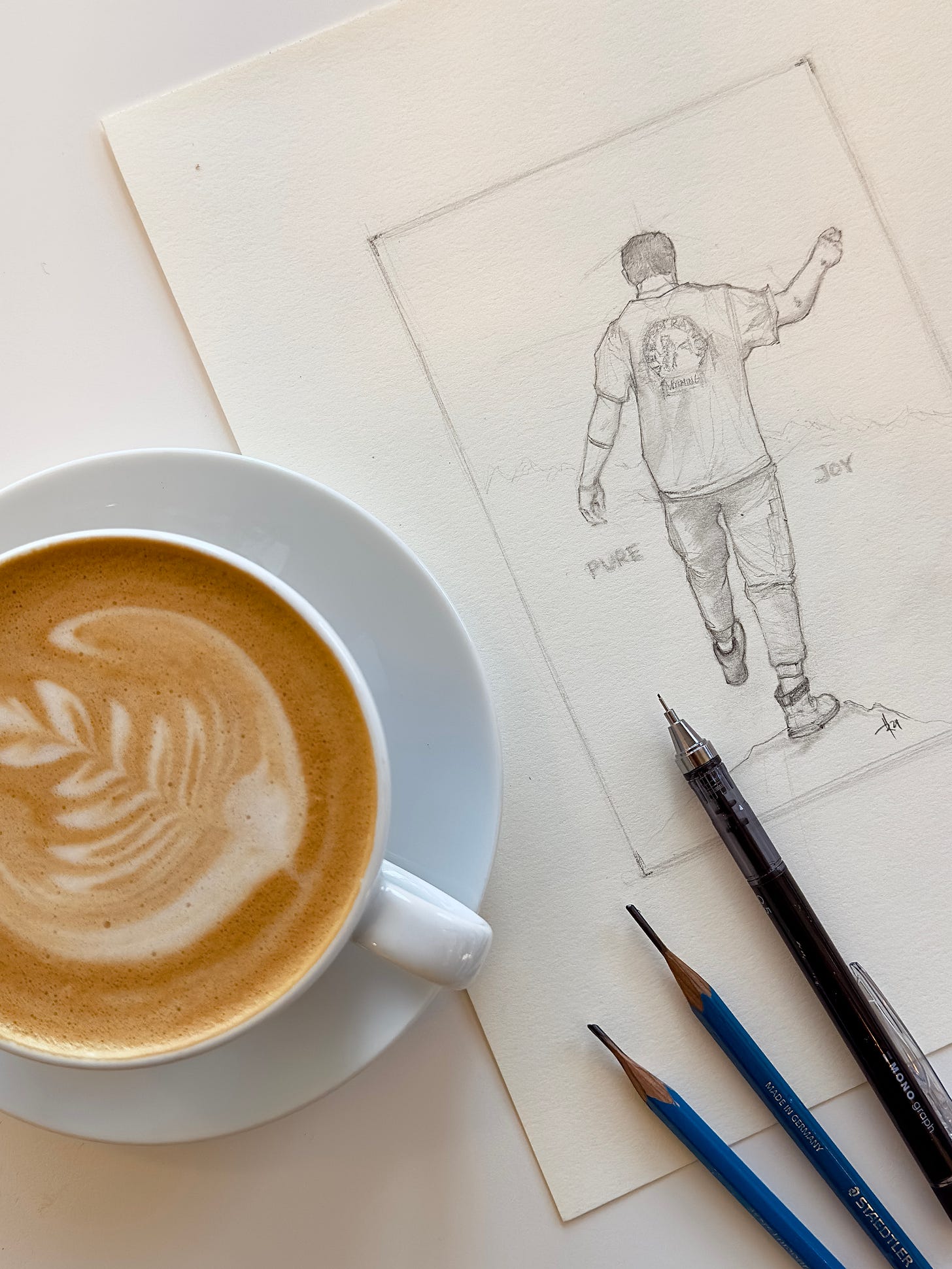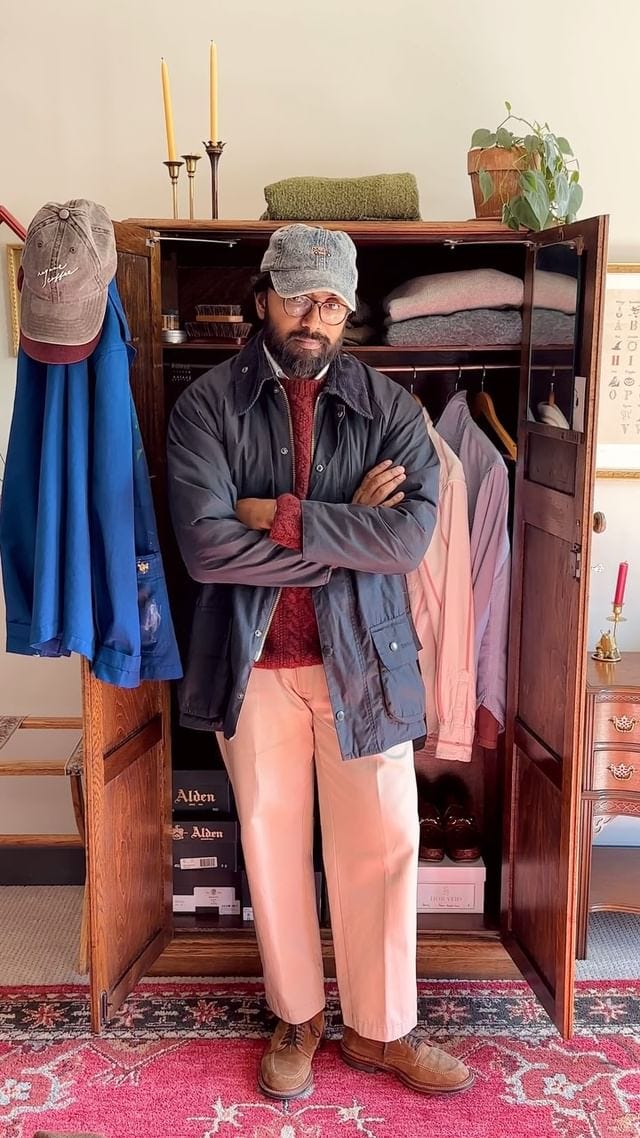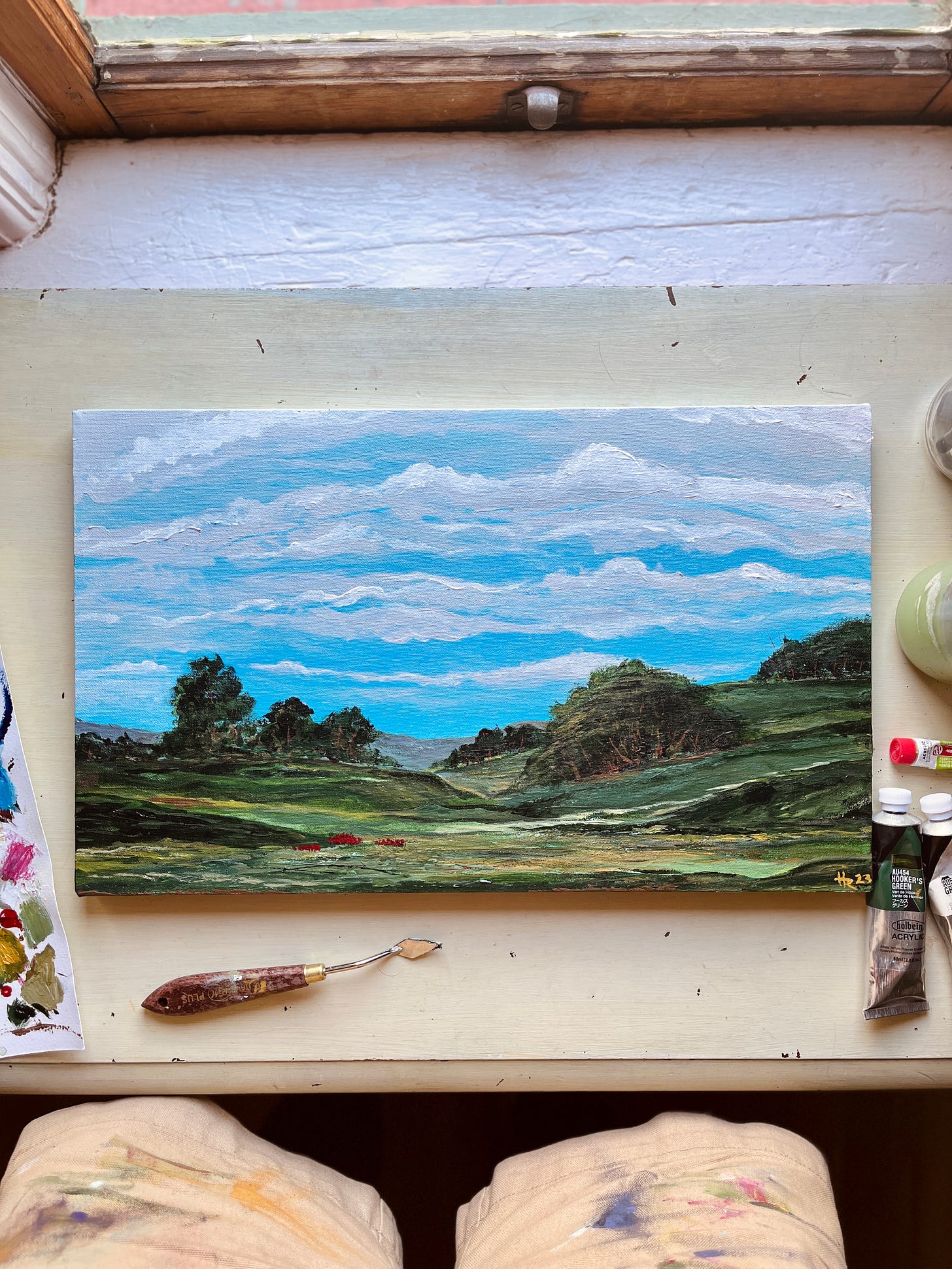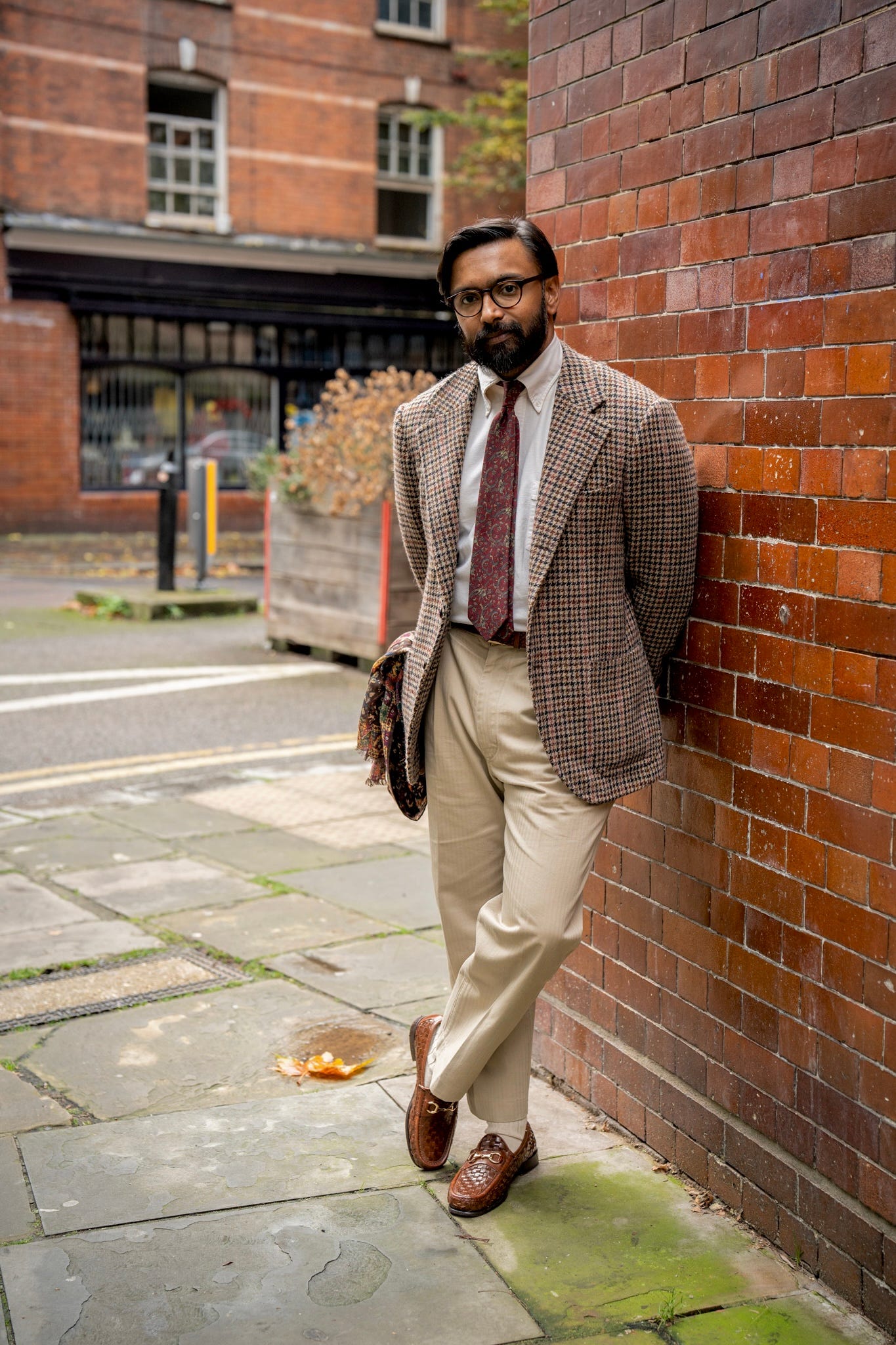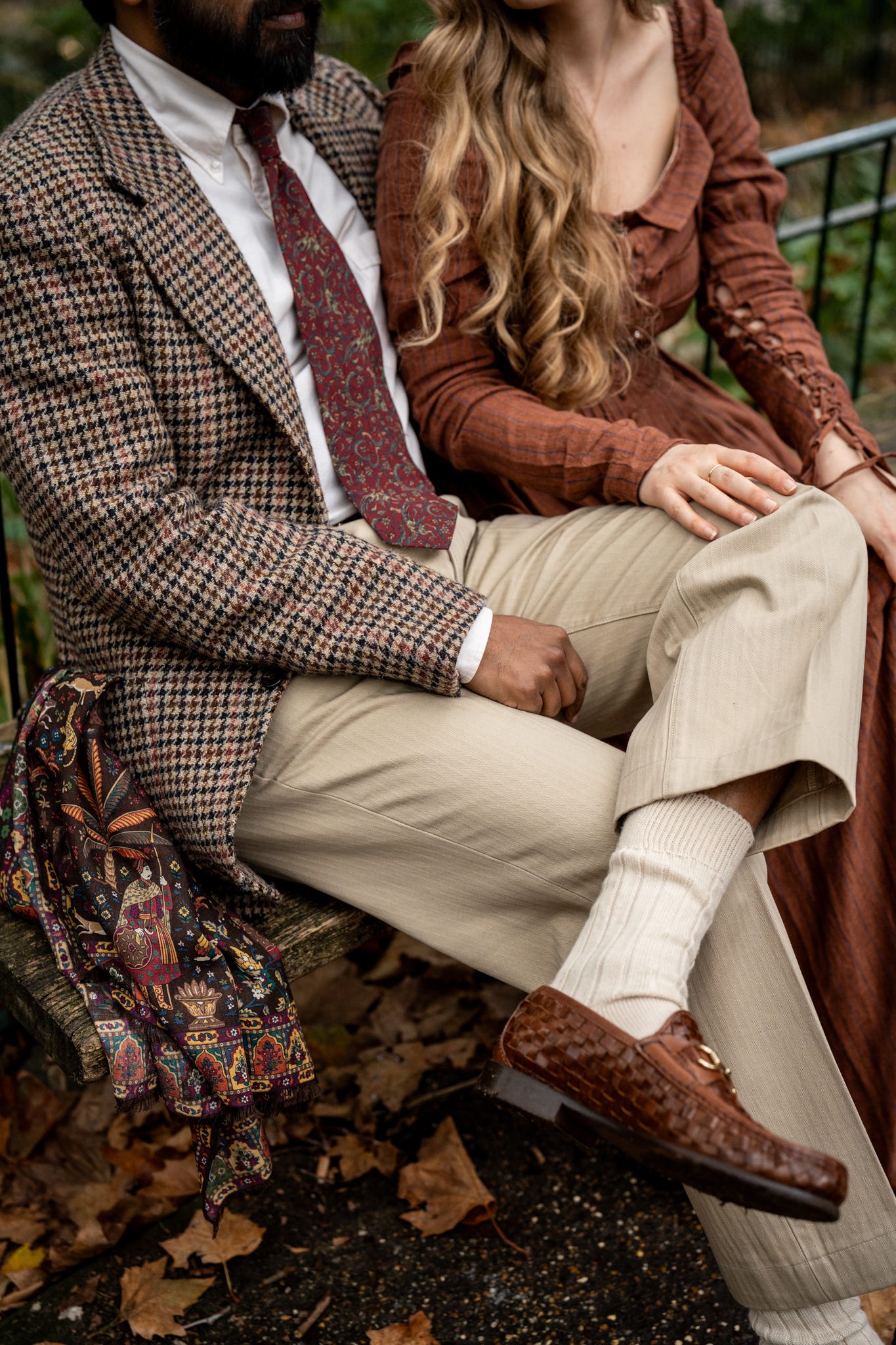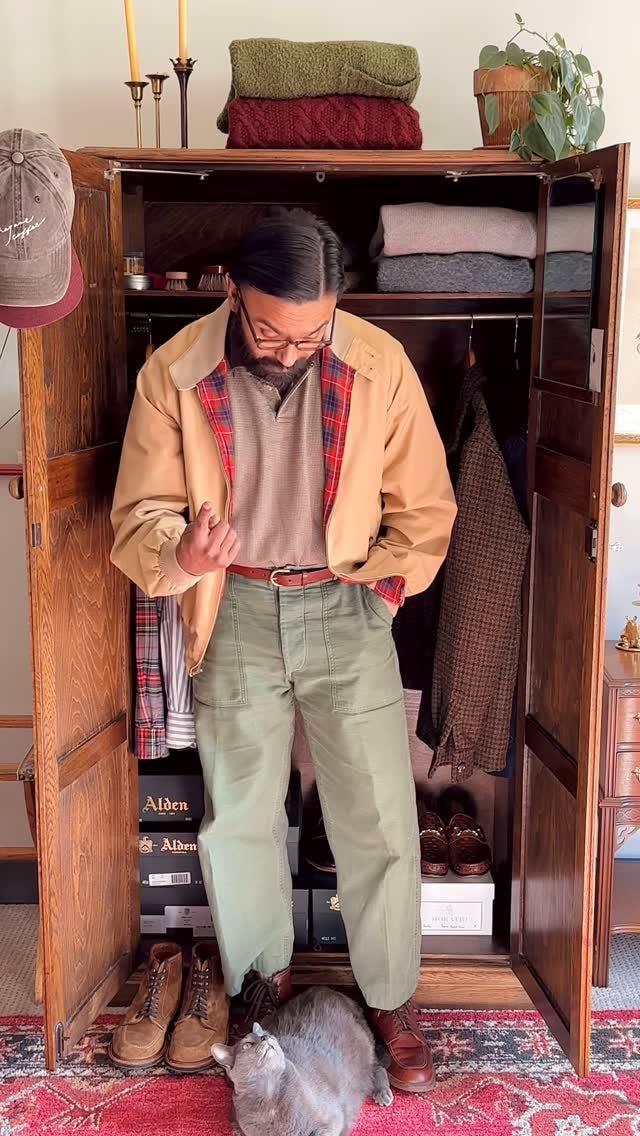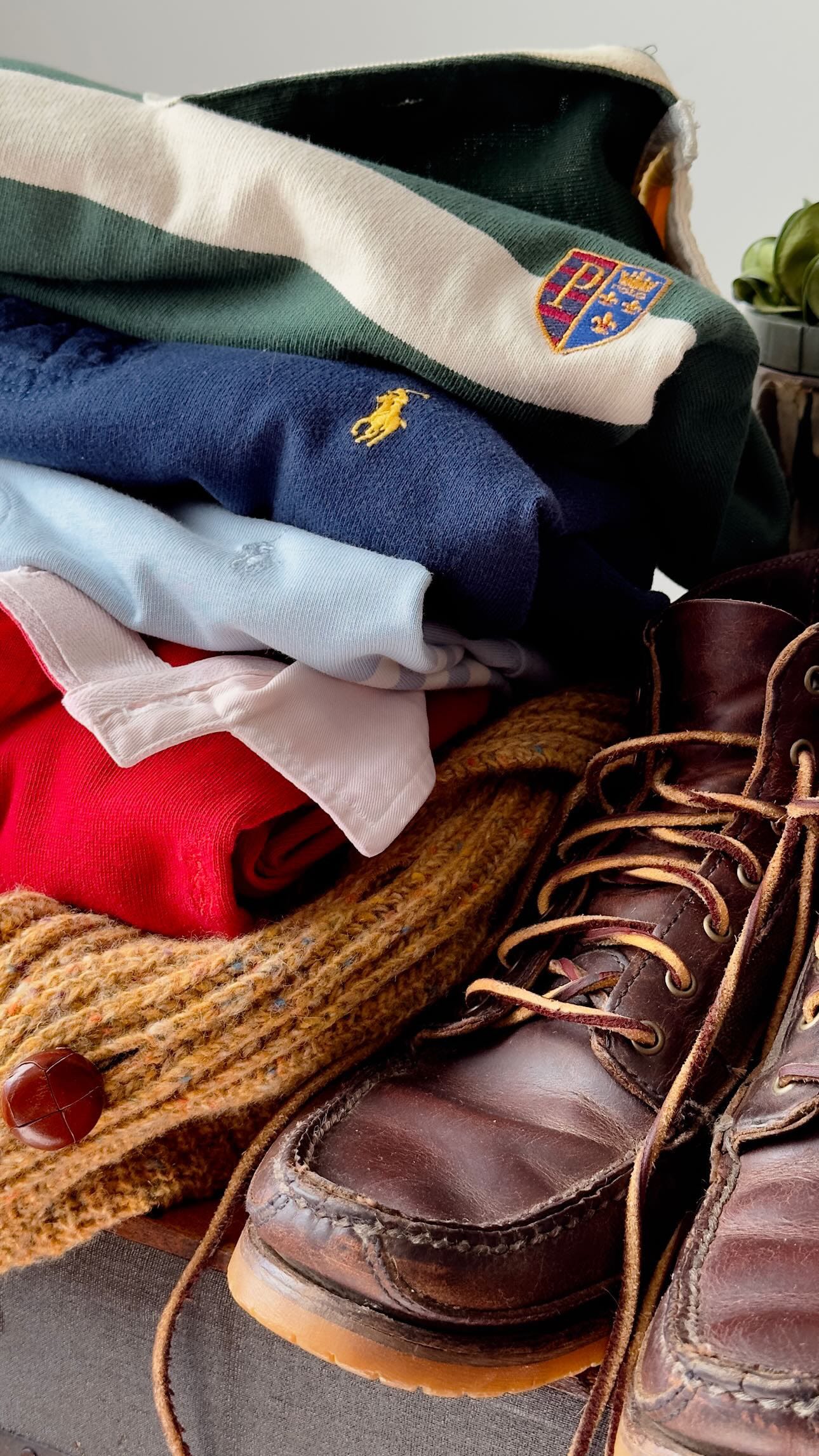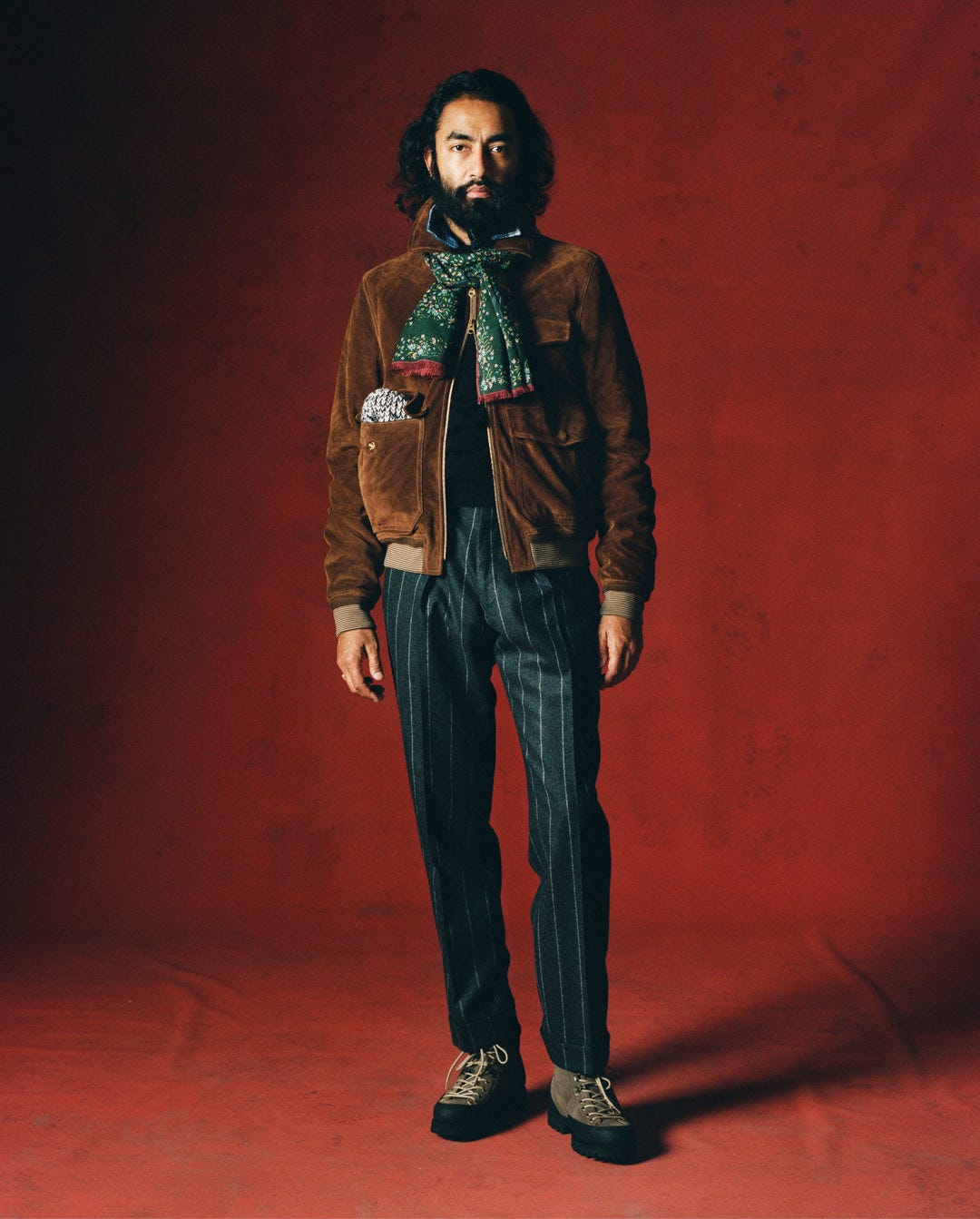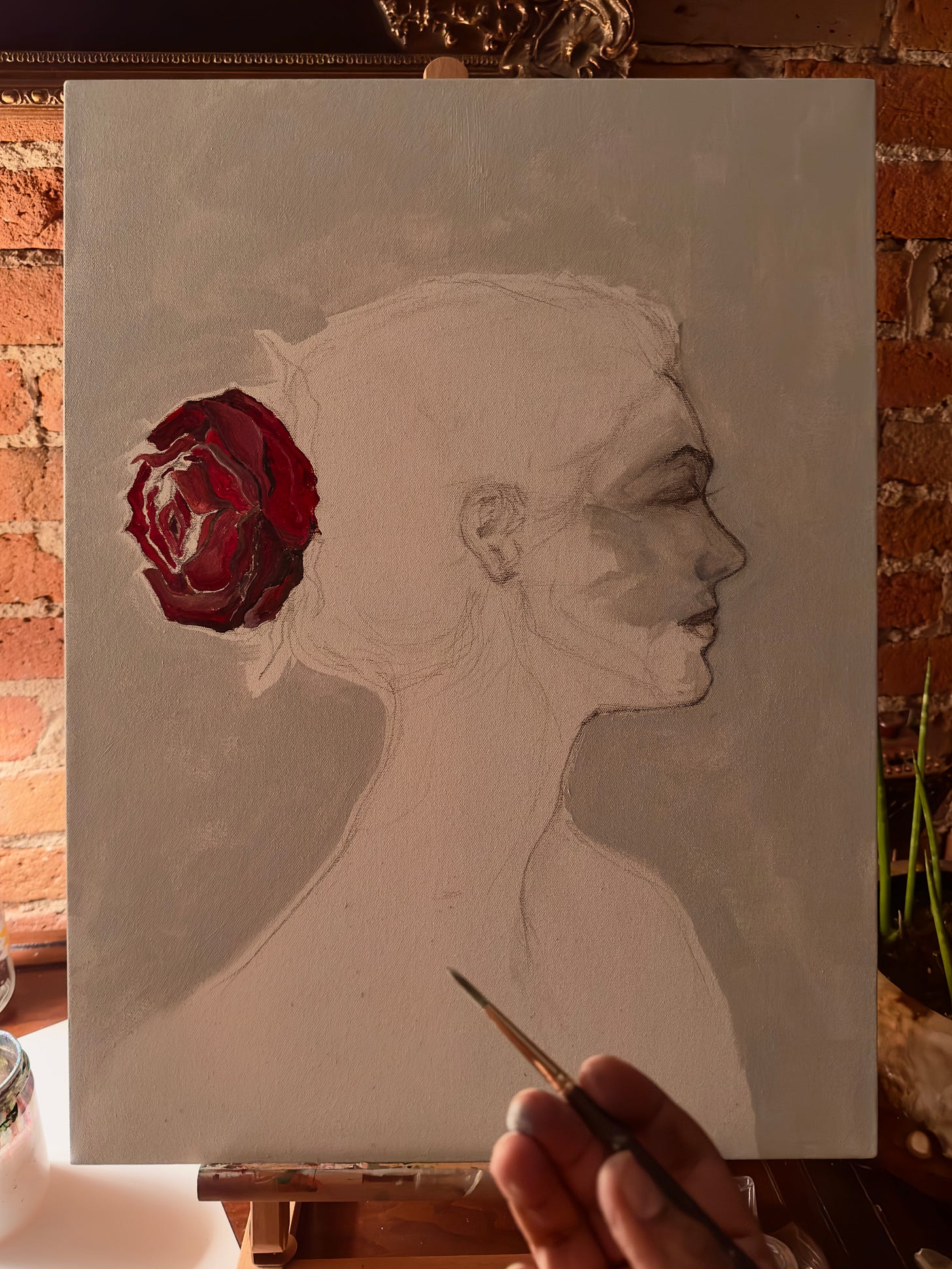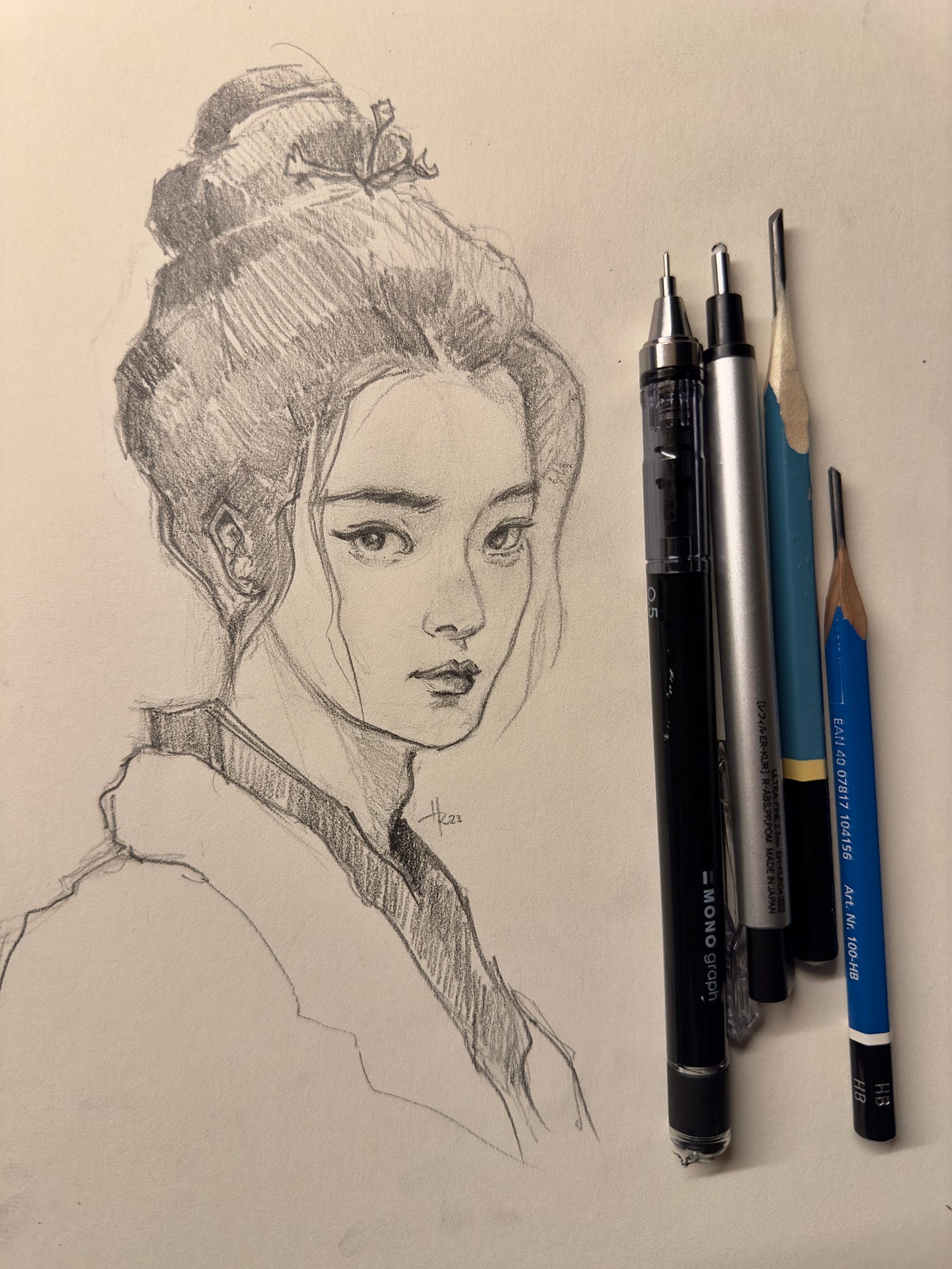Haran Does a Q&A
The PTO Post links up with Atlanta-based renaissance man, Haran Ravindran, about his personal style, art, and what it looks like to pursue your dreams.
Haran & I (Nathan) met by algorithm-induced happenstance. I've seen a few of his videos over the past year or so, and they always stuck out as distinct to me in a way that’s hard to describe. But when you see his videos (the chances are, you have), you’ll know what I mean.
The setting always feels well-considered — and not in a “I made this look like an Aime Leon Dore photoshoot” sort of way. The wooden wardrobe that appears in many videos and photos, his garden, or other corners of his home — much like his clothing — feel decidedly lived-in and authentic to he and his wife’s life together. Rather than feeling staged, it all comes across as a mosaic of intentional decisions made over time and shaped by life experience (not to mention excellent taste).
Ivy is not necessarily style that I’ve connected with in a meaningful way, but Haran has developed his own version of the prep-adjacent attire that really resonates with me — simply put, no one rocks a rugby polo like this dude. It’s this unique style and an air of authenticity his videos exude that made me want to follow along as “Haran does things” (as his IG handle quips).
I realized that Haran was located just down the road from me (and ironically, Zach, too) in the Atlanta area, and he had just moved here a few months before I moved back from NYC. I reached out to him, and before we knew it, we were talking fashion, coffee, and lamenting Atlanta’s lack of walkability.
Zach and I want to use this platform as a place to inspire, inform, and ultimately bring levity to your day, but we also want to use it to highlight creators, creatives, and people in the Atlanta area doing amazing things that can either make your life and/or wardrobe a little better!
Haran was kind enough to lend us his time and answer our questions with care and introspection. We hope you enjoy getting to know him as much as I have!
Q, This may sound like a strange question, but what are your “piano scales”?
This idea is not my own, but ever since I heard it, I’ve been interested in the idea of “piano scales” across different industries and professions — ie, if professional pianist practices their “scales” (the most rudimentary part of their craft) to remain sharp, then what is the equivalent of that for someone else?
You’re an artist, physician, & content creator, so you exist in a vin diagram of proficiency almost entirely your own. Specifically on the creative side — whether in what you wear or what you create — is there something you do each day that essentially acts as your “scales”?
A. I’ve never really thought of this concept of “scales” before. I’ve typically framed it in terms of habits, practices, or rhythms. Truthfully, this is something I’m still working on—especially after a recent cross-country move.
My creative pursuits often feel like a byproduct of wanting to reconnect with myself.
Rick Rubin describes being an artist as “the practice of paying attention” and that resonates deeply with me. I’ve come to prioritize introspection and cherish stillness. I’ve also made it a point to face myself, ask hard questions, and understand why I’m drawn to certain things.
For most of my 20s and 30s, I didn’t give myself the space to explore who I was or what I truly enjoyed. When I turned 40, I realized I didn’t really know myself and many dreams I’d had as a child had been left untouched until recently.
Going back to the idea of “scales,” I’d say wearing things that bring me joy, drawing (something I’m fortunate to do daily), [prioritizing] meaningful rest, spending time outside, and engaging with other peoples’ work—whether music, literature, or art—are all absolutely essential to me.
Q. You’ve been consistently posting on Instagram for a little over a year. What compelled you to start creating content?
A. This might sound cliché, but I didn’t start out with the intention of becoming a content creator when I first began posting on Instagram. Initially, it was just a way for me to share photos and build a personal mood board. Over time, that evolved into using Instagram as a platform to catalog my outfits.
In the process, a whole world opened up. I discovered a community I hadn’t known existed and was honestly shocked to find so many people who share my interests. It made me realize there’s truly a niche for everything. Furthermore, I’ve had the opportunity to meet members of this community in person, which has been so incredibly fun and has led to real friendships.
Creating reels became an opportunity to explore things like editing and setting a scene. Through this, I’ve learned so much about lighting, exposure, and composition. I genuinely enjoy the process—it’s even influenced how I approach art in other mediums. And seeing how other people create content in their own unique ways is incredibly inspiring.
Q. How would you describe your personal style?
A. My personal style is pretty fluid, and I’ve leaned into different styles during various seasons of life. When I lived in New York, I was more into street culture, and my time in Colorado gave me a deep appreciation for rugged Americana.
That said, I think what stitches it all together is a foundation rooted in Ivy style. Of course, Ivy has become such a broad term with countless subcategories, so it’s worth clarifying that I lean less into the traditionalist side (think bright-colored pants, seersucker, or embroidered animals) and more toward a rugged, British, teacher/professorial aesthetic. I gravitate toward tweeds, corduroy, Oxford cloth, raw denim, Shetland sweaters, and cordovan shoes.
I strive for a style I’ll enjoy for years to come, but also love wearing garments and accessories that don’t necessarily fall into an Ivy aesthetic, and find tremendous joy making all of it work together harmoniously.
Q. Was there a time when you felt you started to care more about how you dressed, or has there always been an “opinion” there that just needed time and experience to become more informed?
A. I think I’ve always cared about how I dressed, thanks to the influences around me from a young age. The first person I looked up to in that regard was my father, who was a banker. His wardrobe of suits and ties left a strong impression on me. This was also during our time living in Brooklyn, New York, in the late ’80s to mid-’90s—a cultural melting pot and ground zero for so many influential moments in fashion.
Fast forward to my 20s and 30s, and while I considered myself fashionable, I realize now that I was dressing more in line with what I thought others expected of me. Sure, there was some exploration, but peer acceptance was definitely a priority. I still remember one of my attendings in residency telling us, “Don’t betray people’s expectations of you,” which reinforced that mindset.
It wasn’t until my mid-30s that I started asking myself, “Do I even like these clothes?” That’s when I became more intentional about what I wore. I worked to maintain professionalism while ensuring that my clothing felt authentic to me and genuinely brought me joy. It was a pivotal shift toward dressing for myself rather than for others.
Q. Do you have specific style influences you return to regularly for inspiration? Brands, people, lookbooks, etc?
A. To be fair, the list of specific style influences I return to is a mile long. Right off the bat, I’d say my wife, Kelsey, is probably my biggest influence. I think we play off each other’s style a lot, especially when we’re going out or prepping for a photo shoot.
Everyone I follow on Instagram is hugely influential, too. Books like “Black Ivy” and “Ametora” are fantastic sources of lookbook inspiration. I also have a Pinterest board filled with outfits and color palettes that I revisit occasionally.
Lately, the Drake’s winter lookbook—particularly the pieces modeled by Suren Seneviratne—has been inspiring. I’ve also been drawn to collections from Poszetka, The Merchant Fox, Buck Mason, and Canoe Club. All of them have been incredible touchpoints for my style right now.
Q. Do you take a “uniform” approach to your wardrobe, or do you find yourself drawn to individual pieces and just make the rest work?
These aren’t mutually exclusive, but I find most people either fall into the camp of constantly considering a cohesive “look” or being a bit more eclectic (for lack of a better term) but find a way to bring everything together in the end.
A. Definitely the latter. For the past few years, I’ve found myself drawn to a specific garment and wearing it repeatedly. Through that process, I naturally discover new combinations and patterns that work. Right now, for example, I’ve been anchoring my looks around my Ralph Lauren bifold fleece jackets (I have them in navy, green, and grey). They’ve been a staple for my work outfits lately, and experimenting with new pairings has been a really fun exercise. In the winter, I tend to rotate between sweaters, jackets, and denim, wearing them on repeat—whatever draws me in during that particular stretch of time. It’s a fluid approach that keeps things interesting while letting standout pieces shine.
Q. You dabble a good bit in vintage clothing, which I tend to nerd out about. Is there a particular vintage piece you’re especially proud of or view as your favorite find?
A. Honestly, my favorite vintage pieces are garments I’ve held onto since high school and my early college years
—primarily old Ralph Lauren polos and rugby shirts. I still love wearing them today, and it’s incredible that the quality has held up so well over 20 years later.
I’m also really into collecting vintage fabrics, which I’ve used to make about a dozen or so pocket squares. One project I’m especially excited about is a necktie I’m working on using Donegal wool from the 1950s. The fabric is absolutely stunning, and I’m hoping to finish it in time to wear it this winter.
Q. Current favorite things in the clothing/shoe rotation?
A. As we move into colder temperatures, I’ve really been enjoying my knitwear collection. One standout piece is a Fair Isle sweater from Bosie that I picked up back in the spring but only recently had the chance to wear—I absolutely love it.
I’ve also been rotating between a couple of chore coats. Boltey sent me a Harris Tweed chore coat that’s quickly become a favorite, but most of my time has been spent in a Paynter chore coat in Bills Blue. It’s such a versatile piece, and what I wear when I’m painting.
For shoes, my go-to has been the Beaufoy loafer by Horatio. The basketweave pattern seems to add something special to every outfit and makes even the simplest looks feel elevated.
Q. Current favorite brand(s)?
A. I have a nostalgic soft spot for 1990s and early 2000s Ralph Lauren, J.Crew, and J.Press—they really shaped my style early on.
For denim, I’d have to go with Oni, For Shetlands, I'd go with Bosie or J.Press, and for casual pants, Casatlantic, Buck Mason, and Jack Donnelly are my favorites.
When it comes to shirts, I love Drake’s for their OCBDs, and for tailoring, The Anthology and J.Mueser make incredible blazers. Thunders Love has become my go-to for socks, and for footwear, it’s hard to beat Alden.
I’d also like to bring attention to André of Dredini Sewing Factory and Jeorge Galutia of J.G. Tailoring—both are incredible shirt and clothing makers whose craftsmanship I deeply admire.
Q. If you were starting your wardrobe over from scratch, and you could only use one brand to fill it, what brand/clothing maker would it be?
A. If I had to start my wardrobe over from scratch and could only choose one brand, I think I’d go with Drake’s. Their garments are beautifully made, incredibly versatile, and thoughtfully designed so that everything works seamlessly together—even when mixing casual and formal pieces.
*Photo taken from Drake’s winter ‘24 lookbook, which Haran referenced previously.
Q. We write a lot from the perspective of someone early in the journey of finding their personal style. Any advice for someone just starting that journey of finding their style?
A. First off, I’d say: start slow. You don’t need to figure everything out all at once, and you certainly don’t need to buy an entire wardrobe right away—in fact, I’d strongly encourage you not to.
Instead, I’d argue that discovering your personal style is secondary to getting to know yourself. The more you explore who you are, peel back your layers, and uncover the things in life that genuinely bring you joy, the more your unique style will naturally emerge and blossom from there.
Q. Is there a current trend in men’s fashion you like/want to incorporate more of? One you’d like to see die?
A. To be honest, I don’t really have my ear to the fashion scene closely enough to know what’s trending. That said, I really admire creators who can mix and match styles to craft a look that feels uniquely their own. I also don’t think I’d want any trend to “die” if it’s bringing someone joy in the moment or helping to push men’s fashion forward.
Q. Any current items on your wishlist or long time grails you care to share?
A. I’d like to keep exploring and building on what I already have. For 2025, I’d like to expand my tailoring options and add more suiting for both summer and fall/winter. I’m also eyeing some wool trousers, particularly ones from Casatlantic or O’Connell’s. The Chamula patchwork sweater Drake’s recently released looks incredible, and the reverse chamois Alden Indy boot has been a longtime grail of mine.
I don’t currently own a denim jacket, and that’s something I’m interested in adding. The front-runner is a Type 2 Overdale from RRL—I tried it on at their store in London, and I think about it a lot now.
There’s definitely a lot to consider, but I’m in no rush.
Q. Best music/podcast you’ve listened to lately? Book you’ve read?
A. Lately, I’ve been listening to a lot of Joe Hisaishi, Mk.Gee, the new Tyler album, and Berlioz.
I don’t dive into podcasts too often, but when I do, it’s usually Ritual, Simon Hill, or Gabor Maté. Speaking of Maté, The Myth of Normal has probably been the most impactful book I’ve read this year.
Also on that list: Who Is Wellness For? by Fariha Róisín, The Creative Act by Rick Rubin, and In Praise of Shadows by Junichiro Tanizaki.
Q. Tell me about your journey of making art. You describe briefly on your website the feeling of dreams being mocked as a child. Was drawing/painting something you always loved and wanted to pursue?
A. My journey of making art has been a long time coming, though I’ve always considered myself a creative person. For much of my life, I placed rigid expectations and definitions on what it meant to be an artist. Over time, however, I’ve come to appreciate how art and the act of creation can exist in the smallest, everyday moments.
Thich Nhat Hanh, in his book How to Eat, talks about mindfully appreciating how the entire universe is present in the food we eat. In the same way, creating a delicious meal can be a work of art. The way you set the table before a meal can be a work of art. Even writing a letter, creating a safe haven in your home, or simply witnessing a sunset can all be acts of art and creativity.
Growing up, creativity often took a back seat to practicality and status. My worth was tied to what I could do, contribute, and achieve academically. While I’m proud of what I’ve accomplished professionally, I was rarely given the space to explore my creative side. Drawing was the first thing I ever felt passionate about, and painting has always been something I’ve loved. I’m grateful that I now have the resources and bandwidth to finally explore both.
Q. I think a lot of people can relate to the feeling of a dream being trampled and ultimately suppressed. Do you have a specific breakthrough moment you point to in terms of wanting to pursue this dream of making and selling art and ultimately launching your site?
A. I revisited art in earnest starting in 2018, mostly through sketching, drawing, and studying anatomy and portraiture. By 2021, I had turned 40, and a year into the pandemic, I found myself increasingly disillusioned with my field. I realized that this dream of mine wasn’t going to fulfill itself—no one was going to make it happen for me. If I wanted to pursue it, I had to take the necessary steps.
I thought of my artistic ability as a gift, and I knew I would regret not cultivating it while I still had the chance. Last year, I decided to go part-time in my job, and on the very day I made that shift, I was able to secure an art studio in Denver’s Santa Fe Arts District. That felt like a gift from the universe and gave me the resolve to fully commit to my dream.
My first pieces felt like emotional outpourings—years of bottled-up creativity and expression finally finding their way out. That moment of stepping into the studio and deciding to take myself seriously as an artist was my breakthrough.
Q. Does your art inform your personal style choices in any meaningful way? (Or vice versa?)
A. Perhaps indirectly. Both my art and fashion choices are heavily influenced by color theory. I also gravitate toward timeless, classic aesthetics—whether in art, literature, or fashion. Historical fashion fascinates me, especially learning about the context behind why certain garments were worn by both men and women.
Currently, my work alternates between portraits, landscapes, and florals, and I find myself moving between impressionism and expressionism as I explore and develop my own unique style. I still feel like I’m at the beginning of this journey, but I’m eager to keep learning and evolving.
Q. Lastly, and you can correct me if I’m wrong here, but from the outside, you seem like you’re slightly past the beginning of a journey (publicly sharing & selling your art as well as creating content) that in many ways has been a long time coming. Do you have thoughts you’d share with someone else who has yet to take these same kinds of steps to pursue their passions? Or, rather, words you remind yourself of regularly?
A. This is something I’ve told myself and other artists I’ve met: the world needs your art. It needs everything you’re able to create. It’s okay to struggle, fail, or spend time on something you ultimately hate. It’s also okay to feel invalid or like an impostor at times—that’s part of the process.
There are pieces I’ve made that I didn’t particularly like or feel proud of, yet someone else saw them and fell in love. Once you create something, it’s no longer just yours—it belongs to the beholder. Your work has the power to bring someone joy, evoke a cherished memory, or offer a sense of connection. Even when it feels like you’re stumbling, your art might be exactly what someone else needs.
You can find Haran on Instagram @harandoesthings and find or even purchase his art at artbyharan.com! If you follow along with Haran, you’ll find men’s fashion inspiration, his wonderful paintings and drawings, latte art, and beautifully shot videos of his travels with his wife, Kelsey, among other things.
Thanks again to Haran for sharing his time, perspective, and story with us!


